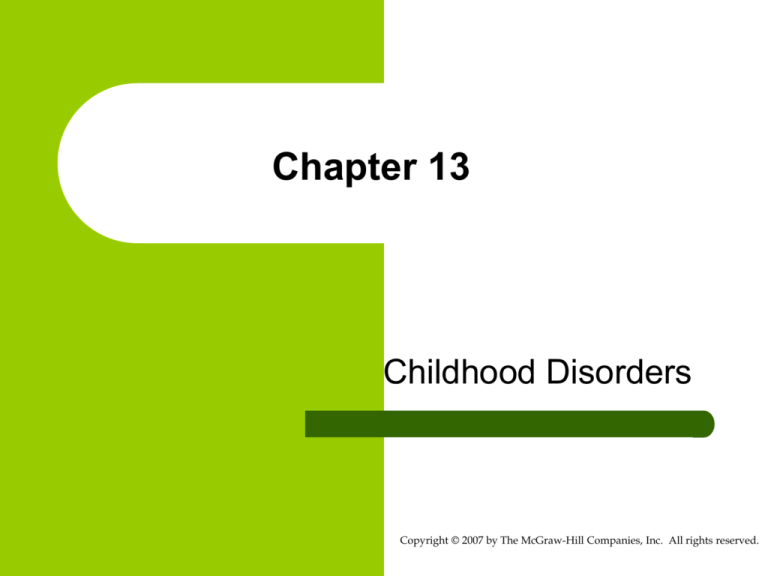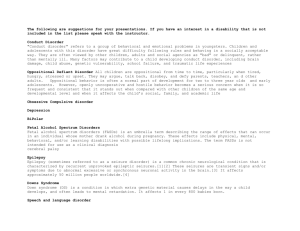
Chapter 13
Childhood Disorders
Copyright © 2007 by The McGraw-Hill Companies, Inc. All rights reserved.
Symptoms of Separation Anxiety
Disorder
Excessive distress when separated from home or
caregivers, or is anticipating separation
Persistent and excessive worry about losing, or harm
coming to, caregivers
Excessively fearful about being alone
Nightmares about separation
Repeated complaints of physical symptoms when
separation from caregivers occurs or is anticipated
Chapter 13
Copyright © 2007 by The McGraw-Hill Companies, Inc. All rights reserved.
Proposed Etiologies for Separation
Anxiety Disorder
Biological: may be genetic
predisposition to anxiety
disorders, including separation
anxiety and panic attacks.
Behavioral inhibition: children
are born with an inhibited, fearful
temperament.
Traumatic and uncontrollable
events: traumatic events can
cause chronic uncontrollability;
parents may encourage fearful
behavior or not encourage
independence.
Chapter 13
Copyright © 2007 by The McGraw-Hill Companies, Inc. All rights reserved.
Effects of Cognitive-Behavioral Therapy
for Separation Anxiety Disorder
80
70
60
50
40
Intervention group
Control Group
30
20
10
0
Pre
intervention
Chapter 13
6 months
24 months
Copyright © 2007 by The McGraw-Hill Companies, Inc. All rights reserved.
Elimination Disorders
Enuresis
–
–
–
–
Chapter 13
Unintended urination at
least 2x/week for 3
months
Child over 5 years of age
Causes may be genetic,
or anxiety/conflicts, or
inappropriate toilet
training
Treated with
medications, bell and
pad method
Encopresis
–
–
–
–
Unintended defecation at
least 1x/month for 3
months
Child over 4 years of age
Usually begins after
episodes of severe
constipation
Treated with medication
and behavioral
contracting
Copyright © 2007 by The McGraw-Hill Companies, Inc. All rights reserved.
Disorders of Cognitive, Motor, and
Communication Skills
Learning
disorders
Reading disorder
Mathematics disorder
Disorder of written expression
Deficits in ability to read
Deficits in mathematics skills
Deficits in the ability to write
Motor skills
disorders
Developmental coordination
disorder
Deficits in the ability to walk, run,
hold on to objects
Communication
disorders
Expressive language disorder
Mixed receptive-expressive
language disorder
Phonological disorder
Stuttering
Deficits in the ability to express
oneself through language
Deficits in the ability both to express
oneself through language and to
understand the language of others
Use of speech sounds inappropriate
for age or dialect
Severe problems in word fluency
Chapter 13
Copyright © 2007 by The McGraw-Hill Companies, Inc. All rights reserved.
Criteria for Mental Retardation
Significantly subaverage intellectual
functioning, indicated by an IQ of
approximately 70 or below
Onset before age 18
Chapter 13
Copyright © 2007 by The McGraw-Hill Companies, Inc. All rights reserved.
Criteria for Mental Retardation,
continued
Significant deficits in at least two of the following
areas:
1. Communication
2. Self-care
3. Home living
4. Social or interpersonal skills
5. Use of community resources
Chapter 13
Copyright © 2007 by The McGraw-Hill Companies, Inc. All rights reserved.
Criteria for Mental Retardation,
continued
Significant deficits in at least two of the following
areas:
6. Self-direction
7. Academic skills
8. Work
9. Leisure
10. Health
11. Personal safety
Chapter 13
Copyright © 2007 by The McGraw-Hill Companies, Inc. All rights reserved.
Biological Causes of Mental
Retardation
Genetic contributions to mental retardation
Prenatal environment
–
–
Drugs and alcohol
Infectious diseases (e.g., rubella, syphilis)
Severe head trauma
Chapter 13
Copyright © 2007 by The McGraw-Hill Companies, Inc. All rights reserved.
Organic Mental Retardation
Typically diagnosed in infancy. There is a clear
history or indicators of a biological abnormality.
The severity of retardation is profound, severe,
or moderate. Parents and siblings are likely to
have intellectual functioning similar to that of the
general population. Socioeconomic status is
representative of that of the general population.
Physical health is poorer than in the general
population.Treatments can improve functioning
but not cure the condition.
Chapter 13
Copyright © 2007 by The McGraw-Hill Companies, Inc. All rights reserved.
Cultural-Familial Mental
Retardation
• It is typically diagnosed at school age
• There may be no history or indicators of
biological abnormality
• The severity of retardation is often mild
• Impairments are specific to certain situations
Chapter 13
Copyright © 2007 by The McGraw-Hill Companies, Inc. All rights reserved.
Cultural-Familial Mental Retardation,
continued
• Parents and siblings are more likely to have
mild retardation
• Occurs often in lower socioeconomic groups
• Physical health is about the same as that in
the general population
• Treatments may cure the condition entirely
Chapter 13
Copyright © 2007 by The McGraw-Hill Companies, Inc. All rights reserved.
Treatments for Mental Retardation
Behavioral
Strategies
Involvement of parents and
caregivers, behavioral modeling,
integrated approach
Drug Therapy
Neuroleptic medications, atypical
antipsychotics to reduce aggression,
antidepressants to reduce depression
Social Programs
Early intervention, mainstreaming,
institutionalization when necessary,
group homes that provide
comprehensive care
Chapter 13
Copyright © 2007 by The McGraw-Hill Companies, Inc. All rights reserved.
Pervasive Developmental
Disorders
Autism
Asperger’s Disorder
Rett’s Disorder
Pervasive Developmental Disorders
Chapter 13
Copyright © 2007 by The McGraw-Hill Companies, Inc. All rights reserved.
Tic Disorders
Tourette’s disorder
Chronic motor or focal tic disorder
Transient tic disorder
Chapter 13
Copyright © 2007 by The McGraw-Hill Companies, Inc. All rights reserved.
Feeding and eating disorders
Pica
Rumination disorder
Feeding disorder of infancy or early
childhood
Chapter 13
Copyright © 2007 by The McGraw-Hill Companies, Inc. All rights reserved.
Other childhood disorders
Selective mutism
Reactive attachment disorder
Stereotypic movement disorder
Chapter 13
Copyright © 2007 by The McGraw-Hill Companies, Inc. All rights reserved.






